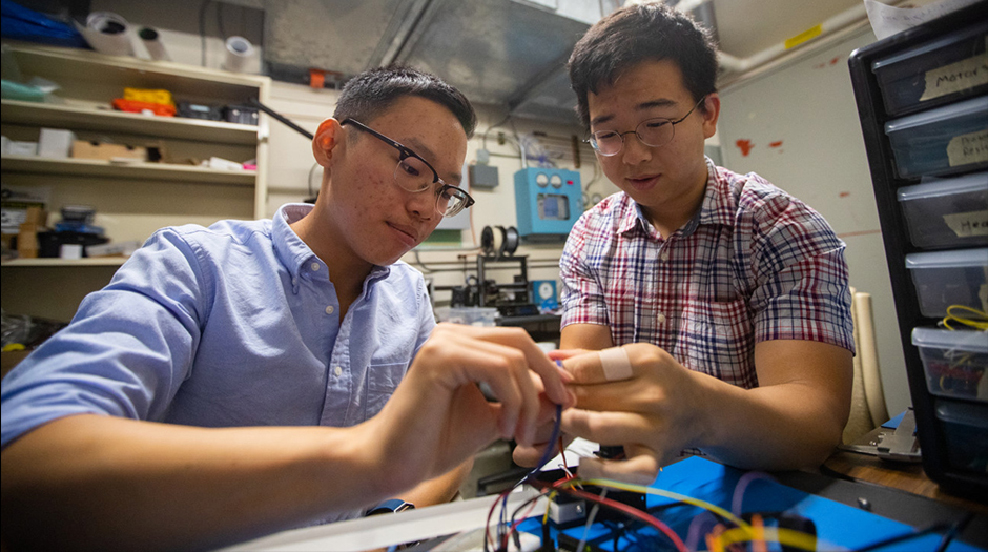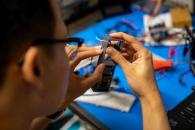
Stephen Sun (left) and Jay Cho spent the summer building a prototype robotic arm for the next Brown Space Engineering satellite.
Credit: Nick Dentamaro/Brown University
With a passion for space and space engineering, two engineering students spent the summer working to design a robotic arm that may fly on Brown's next student-built satellite.
A little over a year ago, the student group Brown Space Engineering put its first satellite — a 4-inch cube called EQUiSat — into orbit. Even as EQUiSat continues to circle the Earth, the group is already thinking about its next satellite, and two engineering students spent the summer working on what may be a key component of that spacecraft: a cubesat-sized robotic arm.
Rising sophomores Jay Cho and Stephen Sun both came to Brown last fall with an interest in space and space engineering. Cho was in a rocketry club in high school, and Sun's admissions essay for Brown focused on his fascination with the recent New Horizons mission to Pluto.
"I actually talked about EQUiSat in my essay and how I wanted to help build satellites with Brown Space Engineering," Sun said.
That chance to help came quickly. Cho and Sun joined BSE shortly after arriving on campus and soon found a project they felt they could tackle for a summer research project — the robotic arm. Arms have been key pieces of equipment on NASA's space shuttles and the International Space Station, helping to deploy, retrieve and repair satellites. The BSE team thought a cubesat-sized arm with a camera on the end would be a great way to capture stunning images from low Earth orbit.

Supported by a Karen T. Romer Undergraduate Teaching and Research Award (UTRA), Cho and Sun spent 10 weeks this summer exploring the possibility of a cubesat arm. They ended up with a working prototype they think could lay the groundwork for future development.
"This is really a proof of concept," Sun said. "We were looking at the arm design and thinking about whether it would work. Then we printed out the parts on a 3D printer, picked out motors and worked with the code for controlling them."
The prototype is about a foot long, with two joints actuated by a series of servo motors. Cho and Sun fitted two cameras to the end, one to capture photographs and one to sense infrared (IR) light. The IR camera is a safety device, the students say. If the arm ends up pointing too directly at the sun, the IR camera sends a signal to move the arm quickly before solar radiation fries the visible light camera.
A major challenge, the students said, was writing the software that controls the arm's position. Commands are sent to the arm in the form of X, Y and Z axis coordinates inputted to a computer. The software then translates those coordinates into the appropriate angles for the motors. Getting all the systems to speak the same language wasn't easy.
"There were some pre-made software tools for similar purposes, but they didn't quite suit our needs," Sun said. "So we had to start from scratch and figure out how to get it to work for our needs. That was really difficult."
Another issue was getting the device to work consistently.
"Sometimes it works perfectly," Cho said. "But sometimes it fails and we have to troubleshoot and analyze what the problems are. That's been a lot of work."
Though much more development needs to be done to get a design that's ready for the rigors of spaceflight, Cho and Sun say they're encouraged that a cubesat robotic arm is a real possibility.
They also came away from the experience as believers in the value of undergraduate research.
"It's especially good in engineering because you're dealing with the real world," Cho said. "Classes are great — you learn a lot of material. But also it's great to be on your own and trying new stuff. UTRA is a great program because you can work on something real."
And that something may one day make it to space.